The 1980’s looked to be a new era for NASA, and space travel on a whole. After the close of the Apollo program, the United States focused its resources towards a new, reusable spacecraft, to act as a space truck to launch satellites, to carry on scientific research and to eventually build a new space station. It was a vehicle that was eventually destined to replace every launch vehicle in the United States arsenal. Atlas, Delta, and even the Titans would be discontinued as the Shuttle took over both civilian and military payloads.
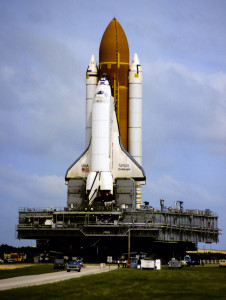
First flying in 1981, the Shuttle was a product of budget cuts to NASA following the successful moon landing of Apollo 11; almost immediately afterwards funds were slashed, missions were canceled, and the ambitious Apollo Applications program was cut down to just enough to create the Skylab space station. The projected, logical missions to Mars using future descendants of the massive Saturn booster were crushed, but future funding did provide money to build the Shuttle.
The original plans for the Shuttle were to use a variant of the Saturn boosters to launch a much smaller orbiter. Through the 70’s these plans would change into the larger vehicle we all know, using 3 main liquid fueled engines in conjunction with 2 massive solid rocket motors to give the vehicle most of its thrust to get into orbit. A unique combination of aircraft and spacecraft, and if I may say, one of the most beautiful machines I have ever seen. 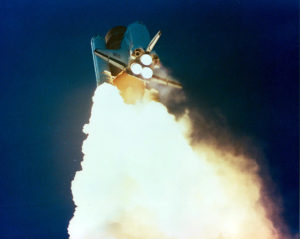
However, this design had flaws. Not to underplay the foam issue that would eventually doom our first orbiter, Columbia, in 2003, what is certainly the most well known and in some ways most tragic demonstration of flaws in the design of the Shuttle came with mission STS-51L, the 25th Space Shuttle mission, and the 10th flight of the orbiter Challenger.
Let’s go back to that day, to that time, from my point of view. More correctly, what I have been told of what happened that day. You see, I was a few days shy of my 1st birthday on that cold morning in 1986. My mother was watching the launch on CNN. So the story goes, she was holding me, as any parent would be when taking care of their child, while watching the launch. I presume I would have watched, as I would be at an age enough to have focused on the TV set, but I digress. Our attention, as that of the nation, was focused on this launch.
I’ve read conflicting reports on whether the event was being watched nationwide or not: All I know is that some areas did have live local feeds, and anyone with cable or satellite TV also had options to watch it live, as we did.
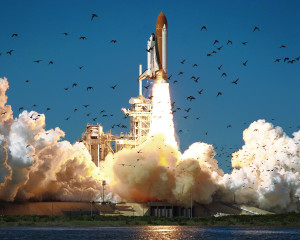
Since 1981, there had been 24 successful launches of the Space Shuttle. We had 4 orbiters in our fleet, Columbia, Challenger, Discover, and Atlantis. In 1985, there were 9 shuttle flights, more launches in one year than there were manned lunar landing attempts in the entire Apollo program. If lunar landings had become “routine” in just a few months after Apollo 11, then Shuttle flights were as mundane as airline flights. The irony is that is exactly what NASA wanted; for space flight to become as routine as an airline flight.
The whole idea with the Shuttle program was that with a reusable craft, launching every satellite, the number of launches and the re-usability of the orbiter would cut costs massively. In practice, this was not the case, but by 1986 shuttle flights were nearly as often as they could physically get, since the External Fuel Tank for the orbiters, the only part to be thrown away after a flight, were limited in production to 12 a year.
The Shuttle Program was an ambitious one, to be sure, but things were looking up. This flight was something special, though. Christa McAuliffe, a teacher, was going to fly and teach from orbit. This was the reason for the national attention; a regular, every-day person was going to fly in space, something that just 20 years beforehand was the realm of test pilots and military men.
Granted, in the previous years, there were flights with personnel related to payloads, and there were senators and even a Saudi prince on one flight, but this was a regular woman, just like the teachers you or I would have had in school.
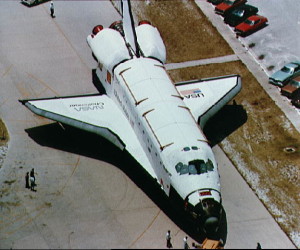
Whatever case, all eyes were glued to the screen as the countdown proceeded. We saw the crew in the white room boarding Challenger as the vehicle was readied for flight. Liquid Hydrogen and Liquid Oxygen were loaded into the bright orange fuel tank, and the Solid Rocket Motors were armed and ready. Everything was go for this launch.
It was an oddly cold morning; the coldest for any shuttle launch. Ice was on the pad in the early mornings before launch, but things had warmed up some by the 11:38 AM Liftoff of the orbiter. Everything looked good, a textbook launch.
73 seconds later, the orbiter disintegrated as the right Solid Rocket Booster tore away from, and then slammed into, the external tank. This tank, containing the liquid fuels for the Space Shuttle Main Engines had been burned through by a jet of flame from the right Solid Rocket Booster right at the joint between the two, causing the failure of the entire vehicle structure. The orbiter, now free flying at incredible velocity 15 Kilometers in altitude, was subjected to stressed far beyond what it was built to endure and emerged from the cloud of debris in pieces, helping give the extremely incorrect impression that persists that the vehicle exploded.
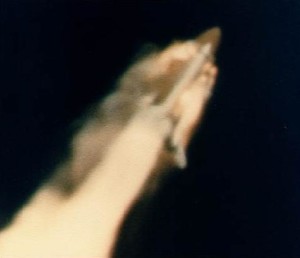
Many people in the crowd didn’t know what happened. Some of them clapped, thinking this was the SRB separation event, which happens 2 minutes into flight. I will save my comments on this, but I will say this much: footage of the crowd during the disaster shows that Christa McAuliffe’s parents knew immediately something had gone wrong.
They weren’t the only ones though; even my mother knew something horrible had happened. She knew that a shuttle launch did not look like that, and she was terrified. The story goes she immediately went to one of her best friends places, taking me with her, to go talk with them about the event, to see if they knew what happened. The rest, as they say, is history.
The evidence suggests that the crew was still alive, some of them conscious, when the crew cabin hit the water a few minutes later. The crew cabin hit at such a velocity that the crew certainly perished upon hitting the water. Their remains, and large portions of the orbiter were recovered, thankfully, and the disaster could be pieced together.
To put it simply, what had happened that day was the failure of a joint in the Solid Rocket Boosters, which let hot gasses leak out, acting almost as a blow torch against the External Tank, not only burning a hole in it, where Liquid Hydrogen could escape, but also weakening the attachment point for the SRB, leading to it pulling away and slamming back into the tank 70 some seconds into the flight.
Why did this happen, though. Why did the Booster fail?
The same reason the Apollo 1 fire happened, if you ask me; a failure to realize something was dangerous. Like in Apollo 1, the pure oxygen environment used had not proven to be a problem in the past, the SRB’s of the Shuttle had not been seen as excessively dangerous.
It turns out this burn through condition had happened before, and engineers at Thiokol, the company that made the boosters for the Shuttle, had tried to warn superiors that this could eventually endanger the Shuttle. Not only that, but the extremely cold temperatures of that morning posed a risk of complete joint failure at launch, which could have had the Shuttle explode at booster ignition.
Challenger, as we all know, didn’t explode on SRB ignition. It is presumed that a piece of slag from the burrning booster fuel had blocked the hole in the booster joint, and if it had held, would have saved the orbiter until SRB separation 2 minutes in. Had that happened, maybe the safety features put in place after the disaster would have been implemented without the loss of the orbiter and its crew, as this burn through was far worse than the damage on previous launches.
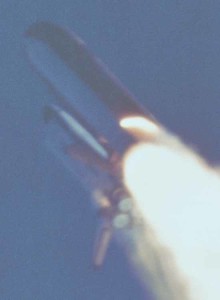
Regardless of the conditions at launch, however, the flame showed itself again just shy of one minute into the flight. The Shuttle had passed through a wind shear event, which buffeted the orbiter far more fiercely than on any previous mission, and this was enough to dislocate the slag that was keeping the hole sealed in the SRB. The flames were able to leak out, and do their damage to the tank.
The Space Shuttle would not fly again until September 1988, with STS-26 and the Return-To-Flight launch of Discovery. I am certain this flight, as well, was a highly publicized event. The difference between it and Challenger 2 years prior, for me, would be that I was 3, almost 4, for STS-26. It is something that I would have been able to watch and pay attention to myself, with of course my Mom watching it herself. I say this because I have always, for as early as I can remember, been fascinated by space travel, and due to the time I was born, the only thing I can presume is that STS-26 was the event that I would have seen to make me fall in love with the idea of humans, or indeed, of anything man made, going out into the void.
Of course, I would have no memories of seeing that launch, and I certainly would have no memories of Challenger… but I know I, as a baby, watched it happen. I don’t think of it though as me watching a disaster, or watching 7 people die. I think of it as the closest thing to destiny for me, just as being born on the same day (27 years later, though) as the first US Satellite launch, and also the launch of Apollo 14 (Which was 15 years before I was born) is symbolic in retrospect. Not that I believe in such, but it is quite poetic to think about how the week surrounding my birthday is filled with so much triumph and tragedy.
I will never stop supporting any and all forms of human spaceflight. That simple. I feel it is in our very DNA to explore, and to wonder about the universe itself; to deny ourselves the chance to do such is to deny something that makes us human.
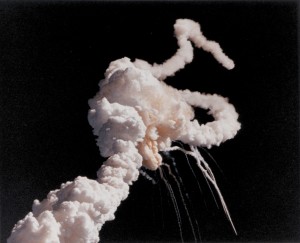
As for Challenger and her crew, on this, the 30th anniversary of this tragedy, look to the sky, as I asked you to yesterday, and imagine, 30 years ago, Challenger successfully in orbit. Imagine the crew launching, conducting research, and history being made as Christa taught school children all across the nation a lesson that was literally out of this world. Imagine a crew of rookies and veterans all enjoying the experience of being 200 kilometers above the Earth, but even more so, think to when they would come home, to their friends, families, pets, and to future flights, possibly again on board the Challenger.
The Shuttle program would continue until 2011, with another disaster striking in Feburary of 2003 with the loss of Columbia. This would prove to be the beginning of the end for the Space Shuttle Program, but in those remaining 6 years of flights, from 2005 to 2011, we would see the completion of the Internation Space Station, an outpost that is in many ways the beginning point to our future mission plans to Mars.
in a way, the Shuttle did what it was intended to do, even if it took the long way around to do it. Sadly, it took the loss of Challenger and Columbia to bring this about, but much like the loss of the Apollo 1 crew in 1967, we will not only learn from our history, but I feel even decades later it will drive us to better heights than we had ever planned for.
30 years later, but still, to some of us, so very recent.
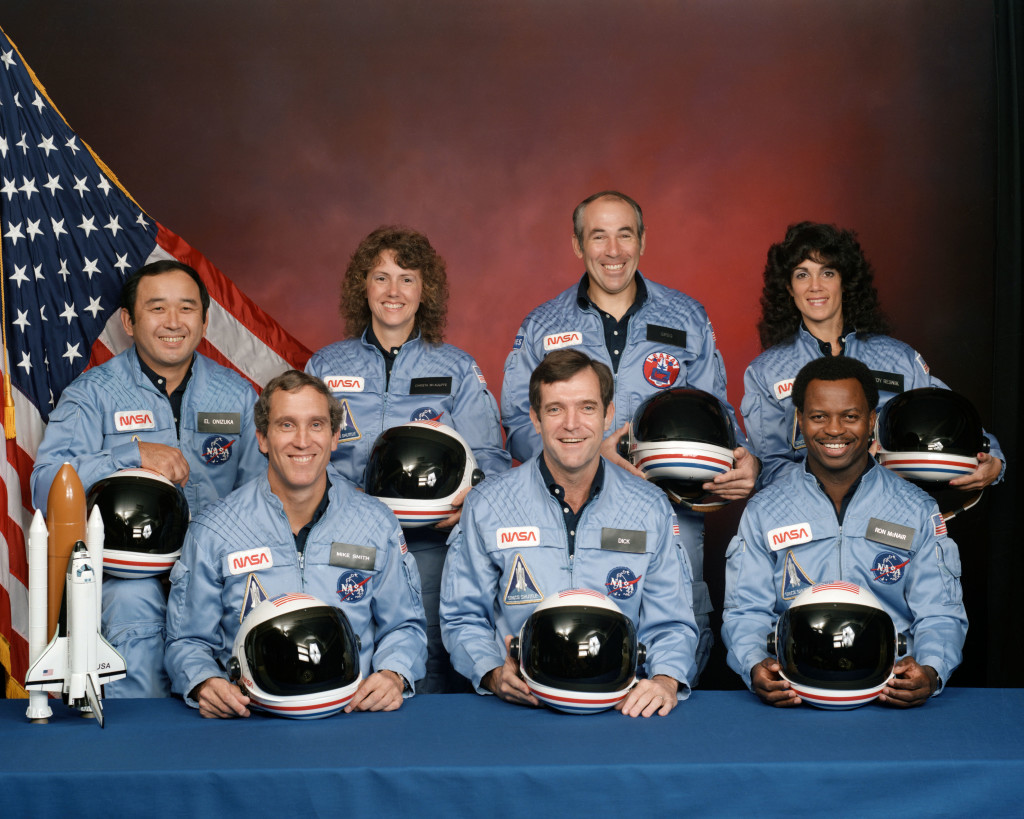
Godspeed, Challenger.
Francis R. Scobee
Michael J. Smith
Ellison S. Onizuka
Judith A. Resnik
Ronald E. McNair
Gregory B. Jarvis
S. Christa McAuliffe
https://en.wikipedia.org/wiki/Space_Shuttle_Challenger
https://en.wikipedia.org/wiki/STS-51-L
https://en.wikipedia.org/wiki/STS-51-L_Mission_timeline
CNN recording the hour of launch: https://www.youtube.com/watch?v=1rDg7S46ijM
For those who have quite a bit of time on their hands, a complete CBS recording for nearly 6 hours on that day.
https://www.youtube.com/watch?v=N9kWG-lAOCA
It is worth noting that like yesterdays Apollo 1 article, I have scheduled this article at the time of the disaster.
